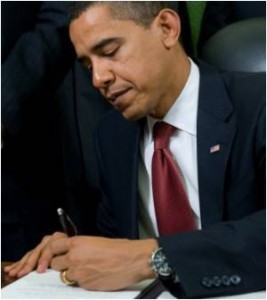 While it has come to the foreground again as we approach national elections, the executive order has been around for a long time. Among Republican candidates, Newt Gingrich has posted the first four executive order he will issue if elected, while Ron Paul has vowed to issue just one, an order to eliminate the executive order. So who do we listen to, and what should be done about these orders that pass though no legislative body and only require the signature of one man, the President of the United States?
While it has come to the foreground again as we approach national elections, the executive order has been around for a long time. Among Republican candidates, Newt Gingrich has posted the first four executive order he will issue if elected, while Ron Paul has vowed to issue just one, an order to eliminate the executive order. So who do we listen to, and what should be done about these orders that pass though no legislative body and only require the signature of one man, the President of the United States?
A Brief History
Executive orders have been issued by every chief executive since and including George Washington. In the early 1900s, the State Department began numbering them, and there are now over 13,000 numbered orders. Orders were retroactively numbered going back to 1862 when President Lincoln suspended the writ of habeas corpus and issued the Emancipation Proclamation by Executive Order. Due to poor record keeping, many older orders were issued but never numbered.
Some of the most famous incidents of Executive Order include:
- Abraham Lincoln – Issued the Emancipation Proclamation (Executive Order #1) in 1863. Lincoln also suspended citizens’ rights through Habeas Corpus during the war by executive order.
- Franklin Roosevelt – During World War II, FDR issued executive orders to remove Japanese-American to internment camps.
- Harry Truman – Integrated the armed forces under an executive order.
- Dwight Eisenhower – Used an executive order to desegregate schools.
- John F. Kennedy and Lyndon B. Johnson – Used executive orders to prohibit racial discrimination.
- Ronald Reagan – Barred the use of federal funds for advocating abortion.
- Bill Clinton – Reversed this order when he came into office. While many presidents used them, the executive order began to come under scrutiny by conservatives during the Clinton administration. He signed well over 300 executive orders including a much-criticized incident when he designated 1.7 million acres of Southern Utah as Escalante National Monument. He even executed the war in Yugoslavia under executive order.
Since 9/11, both George W. Bush and Barack Obama have used executive orders extensively, but no other president comes even close to FDR’s use of the orders during his administrations. Roosevelt issued 3,738 executive orders, ten times as many as either Bill Clinton or George W. Bush.
Can Executive Order Be Overruled?
If Congress does not like what the executive branch is doing, it has two main options. It can rewrite or amend a previous law or spell it out in greater detail how the executive branch must act. Of course, the President has the right to veto the bill if he disagrees with it, so, in practice, a two-thirds majority if often required to override an executive order.
Congress is less likely to challenge orders that deal with foreign policy, national defense, or the implementation and negotiation of treaties, because those are powers granted largely to the President by the Constitution. As the Commander-in-Chief of the armed forces, the President is also considered the nation’s “Chief Diplomat.” In fact, given national security concerns, some defense or security related executive orders (often called National Security Directives or Presidential Decision Directives) are not made public.
Executive orders can also be challenged in court, on the grounds that the order deviates from “congressional intent” or exceeds the President’s constitutional powers. In one such notable instance, President Harry Truman was rebuked by the Supreme Court for overstepping the bounds of presidential authority. After World War II, Truman seized control of steel mills across the nation in an effort to settle labor disputes. In response to a challenge of this action, the Supreme Court ruled that the seizure was unconstitutional and exceeded presidential powers because neither the Constitution nor any statute authorized the President to seize private businesses to settle labor disputes. For the most part, however, the Court has been fairly tolerant of wide range of executive actions.
Are They Unconstitutional?
Congressman Ron Paul believes the practice of issuing executive orders is unconstitutional. In an interview with Megan Kelly of FOX News he said:
The constitution says that only Congress passes laws. The executive branch is not allowed to pass laws, nor should the judicial system pass laws. So it is clearly unconstitutional to issue these executive orders. They’ve been done for a long time, both parties have done it, but the Congress is careless. They allow and encourage and do these deals, like they have this time, to get the President to circumvent the Congress. If something’s unpopular and he can’t get it passed, well, let’s just sign an executive order. So I think that is blatantly wrong. I think this defies everything the founders intended.
Now candidate Paul has clearly stated his one and only executive order would be to eliminate executive orders on the basis they are unconstitutional. While Paul can declare he will never use these orders while he is president, he can’t declare them unconstitutional; that task lies with the Supreme Court.
What to Do About the Abuse
If executive orders as a practice are unconstitutional, the question has to arise, why haven’t they been judged so by any Supreme Court since our country’s inception? A better statement would be to say the evolution of the executive order over the last century has changed its very nature. The executive order may not be unconstitutional, but the way it is now implemented is certainly contrary to the intent of the founding fathers and the separation of powers detailed in the Constitution.
The lesson that all too many conservatives seem to have drawn from the Clinton years is not that executive power needs to be better defined and controlled but that it needs to be exercised by a Republican. Likewise, one might think two terms of a George W. Bush presidency would teach the Left a thing or two about executive power, but for all their carping at the president, most liberals seem quite happy with the status quo as long as the president issues executive orders on behalf of fashionable causes. Then when another neoconservative takes office and uses that power as George W. Bush has, the Left will trot out its now familiar routine of shock and indignation. Some opposition.
Both liberals and at least some conservatives must share the blame for contributing to an ideological climate of which the inevitable outcome is the unrestrained executive under which our Republic now groans. Ultimately, though, apportioning responsibility for this transformation of the presidency, in which its occupant can flagrantly and defiantly violate the law, is of much less urgency than addressing-and, one hopes, correcting-the present debacle. (The Daily Reckoning)
There must be some middle ground in reigning in both the abuses of Congress, the Court, and the Executive Branch, because all three are guilty. Conservative Presidents have reacted against courts acting like lawmakers, and Congress reacts against Presidents that seek to get something done when Congress refuses. The danger in all of this is to lost sight of the genius of the system left to us by the founders.
Maybe someone will issue an executive order mandating common sense. Until then, this issue will not be settled be a simple edict or by looking the other way.
©2012 Off the Grid News
 Off The Grid News Better Ideas For Off The Grid Living
Off The Grid News Better Ideas For Off The Grid Living



